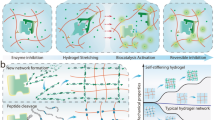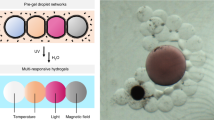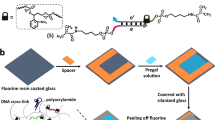Abstract
Surfaces with physicochemical properties that can be modulated using external stimuli offer great promise for designing responsive or adaptive materials. Here, we describe biocompatible dynamic scaffolds based on thin hydrogel coatings that reversibly hide and display surface chemical patterns in response to temperature changes. At room temperature, the gel absorbs water, triggering an elastic creasing instability that sequesters functionalized regions within tight folds in the surface. Deswelling at ∼37 ∘C causes the gel surface to unfold, thereby regenerating the biomolecular patterns. Crease positions are directed by topographic features on the underlying substrate, and are translated into two-dimensional micrometre-scale surface chemical patterns through selective deposition of biochemically functionalized polyelectrolytes. We demonstrate specific applications of these dynamic scaffolds—selective capture, sequestration and release of micrometre-sized beads, tunable activity of surface-immobilized enzymes and reversible encapsulation of adherent cells—which offer promise for incorporation within lab-on-a-chip devices or as dynamic substrates for cellular biology.
This is a preview of subscription content, access via your institution
Access options
Subscribe to this journal
Receive 12 print issues and online access
$259.00 per year
only $21.58 per issue
Buy this article
- Purchase on Springer Link
- Instant access to full article PDF
Prices may be subject to local taxes which are calculated during checkout




Similar content being viewed by others
References
Mather, P. T. Soft answers for hard problems. Nature Mater. 6, 93–94 (2007).
Russell, T. P. Surface-responsive materials. Science 297, 964–967 (2002).
Lahann, J. & Langer, R. Smart materials with dynamically controllable surfaces. MRS Bull. 30, 185–188 (2005).
Wang, R. et al. Light-induced amphiphilic surfaces. Nature 388, 431–432 (1997).
Ichimura, K., Oh, S. K. & Nakagawa, M. Light-driven motion of liquids on a photoresponsive surface. Science 288, 1624–1626 (2000).
Lahann, J. et al. A reversibly switching surface. Science 299, 371–374 (2003).
Sun, T. L. et al. Reversible switching between superhydrophilicity and superhydrophobicity. Angew. Chem. Int. Ed. 43, 357–360 (2004).
Fu, Q. et al. Reversible control of free energy and topography of nanostructured surfaces. J. Am. Chem. Soc. 126, 8904–8905 (2004).
Ionov, L. et al. Reversible chemical patterning on stimuli-responsive polymer film: Environment-responsive lithography. J. Am. Chem. Soc. 125, 8302–8306 (2003).
Lim, H. S., Han, J. T., Kwak, D., Jin, M. H. & Cho, K. Photoreversibly switchable superhydrophobic surface with erasable and rewritable pattern. J. Am. Chem. Soc. 128, 14458–14459 (2006).
Chung, J. Y., Youngblood, J. P. & Stafford, C. M. Anisotropic wetting on tunable micro-wrinkled surfaces. Soft Matter 3, 1163–1169 (2007).
Crevoisier, G. B., Fabre, P., Corpart, J. M. & Leibler, L. Switchable tackiness and wettability of a liquid crystalline polymer. Science 285, 1246–1249 (1999).
Jones, D. M., Smith, J. R., Huck, W. T. S. & Alexander, C. Variable adhesion of micropatterned thermoresponsive polymer brushes: AFM investigations of poly (N-isopropylacrylamide) brushes prepared by surface-initiated polymerizations. Adv. Mater. 14, 1130–1134 (2002).
Lin, P. C., Vajpayee, S., Jagota, A., Hui, C. Y. & Yang, S. Mechanically tunable dry adhesive from wrinkled elastomers. Soft Matter 4, 1830–1835 (2008).
Kang, Y., Walish, J. J., Gorishnyy, T. & Thomas, E. L. Broad-wavelength-range chemically tunable block-copolymer photonic gels. Nature Mater. 6, 957–960 (2007).
Hu, Z. B., Chen, Y. Y., Wang, C. J., Zheng, Y. D. & Li, Y. Polymer gels with engineered environmentally responsive surface patterns. Nature 393, 149–152 (1998).
Jiang, X. Y., Ferrigno, R., Mrksich, M. & Whitesides, G. M. Electrochemical desorption of self-assembled monolayers noninvasively releases patterned cells from geometrical confinements. J. Am. Chem. Soc. 125, 2366–2367 (2003).
Yeo, W. S., Yousaf, M. N. & Mrksich, M. Dynamic interfaces between cells and surfaces: Electroactive substrates that sequentially release and attach cells. J. Am. Chem. Soc. 125, 14994–14995 (2003).
Akiyama, Y., Kikuchi, A., Yamato, M. & Okano, T. Ultrathin poly(N-isopropylacrylamide) grafted layer on polystyrene surfaces for cell adhesion/detachment control. Langmuir 20, 5506–5511 (2004).
Zhu, X. Y. et al. Fabrication of reconfigurable protein matrices by cracking. Nature Mater. 4, 403–406 (2005).
Frey, W., Meyer, D. E. & Chilkoti, A. Dynamic addressing of a surface pattern by a stimuli-responsive fusion protein. Adv. Mater. 15, 248–251 (2003).
Sikes, H. D. et al. Using polymeric materials to generate an amplified response to molecular recognition events. Nature Mater. 7, 52–56 (2008).
Tojo, E., Nagao, K., Miura, T. & Nagamoto, S. in Photographic Gelatin (ed. Cox, R. J.) 49–61 (Academic, 1972).
Tanaka, T. et al. Mechanical instability of gels at the phase-transition. Nature 325, 796–798 (1987).
Trujillo, V., Kim, J. & Hayward, R. C. Creasing instability of surface-attached hydrogels. Soft Matter 4, 564–569 (2008).
Hirotsu, S., Hirokawa, Y. & Tanaka, T. Volume-phase transitions of ionized N-isopropylacrylamide gels. J. Chem. Phys. 87, 1392–1395 (1987).
Li, C. F., Hu, Z. B. & Li, Y. Temperature and time dependencies of surface patterns in constrained ionic N-isopropylacrylamide gels. J. Chem. Phys. 100, 4645–4652 (1994).
Bysell, H. & Malmsten, M. Visualizing the interaction between poly-L-lysine and poly(acrylic acid) microgels using microscopy techniques: Effect of electrostatics and peptide size. Langmuir 22, 5476–5484 (2006).
Hermanson, G. T. Bioconjugate Techniques 1st edn (Academic, 1996).
Kenausis, G. L. et al. Poly(L-lysine)-g-poly(ethylene glycol) layers on metal oxide surfaces: Attachment mechanism and effects of polymer architecture on resistance to protein adsorption. J. Phys. Chem. B 104, 3298–3309 (2000).
VandeVondele, S., Voros, J. & Hubbell, J. A. RGD-grafted poly-L-lysine-graft-(polyethylene glycol) copolymers block non-specific protein adsorption while promoting cell adhesion. Biotechnol. Bioeng. 82, 784–790 (2003).
Hong, W., Liu, Z. & Suo, Z. Inhomogeneous swelling of a gel in equilibrium with a solvent and mechanical load. Int. J. Solids Struct. 204, 3282–3289 (2009).
Panteghini, M., Bonora, R. & Pagani, F. Measurement of pancreatic lipase activity in serum by a kinetic colorimetric assay using a new chromogenic substrate. Ann. Clin. Biochem. 38, 365–370 (2001).
Kamenjicki, M., Lednev, I. K., Mikhonin, A., Kesavamoorthy, R. & Asher, S. A. Photochemically controlled photonic crystals. Adv. Funct. Mater. 13, 774–780 (2003).
Miyata, T., Asami, N. & Uragami, T. A reversibly antigen-responsive hydrogel. Nature 399, 766–769 (1999).
Zhao, X. M., Xia, Y. N. & Whitesides, G. M. Soft lithographic methods for nano-fabrication. J. Mater. Chem. 7, 1069–1074 (1997).
Acknowledgements
We are grateful to Z. Suo and X. Zhao for helpful discussions and for providing the user-defined Abaqus subroutines used to model swelling of hyperelastic gels, and to P. Wadsworth and C. Fagerstrom for providing cells and assisting with cell culture experiments. This work was primarily financially supported by the National Science Foundation through grant DMR-0747756 with further support provided by a 3M Nontenured Faculty Grant, and made use of facilities supported by the NSF MRSEC at UMass (DMR-0820506) and NSF grant BBS-8714235. J.Y. is partially supported by the Korean Research Foundation (KRF-2008-357-D00079).
Author information
Authors and Affiliations
Contributions
R.C.H. and J.K. designed the research project and experiments. J.K. carried out the bulk of experiments and simulations; J.Y. characterized temperature-dependent swelling behaviours of the gel networks. R.C.H. and J.K. primarily wrote the paper with input and comments from J.Y.
Corresponding author
Ethics declarations
Competing interests
The authors declare no competing financial interests.
Supplementary information
Supplementary Information
Supplementary Information (PDF 963 kb)
Supplementary Information
Supplementary Movie (MOV 6256 kb)
Rights and permissions
About this article
Cite this article
Kim, J., Yoon, J. & Hayward, R. Dynamic display of biomolecular patterns through an elastic creasing instability of stimuli-responsive hydrogels. Nature Mater 9, 159–164 (2010). https://doi.org/10.1038/nmat2606
Received:
Accepted:
Published:
Issue Date:
DOI: https://doi.org/10.1038/nmat2606
This article is cited by
-
Surface Creasing-Induced Micropatterned GelMA Using Heating-Hydration Fabrication for Effective Vascularization
Tissue Engineering and Regenerative Medicine (2021)
-
Multipolar spatial electric field modulation for freeform electroactive hydrogel actuation
Scientific Reports (2020)
-
Bioinspired Multiscale Wrinkling Patterns on Curved Substrates: An Overview
Nano-Micro Letters (2020)
-
Advances in biomimetic stimuli responsive soft grippers
Nano Convergence (2019)
-
Cellular responses to beating hydrogels to investigate mechanotransduction
Nature Communications (2019)



